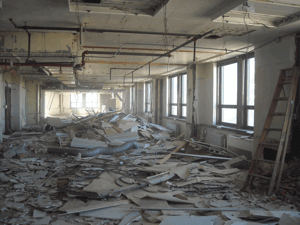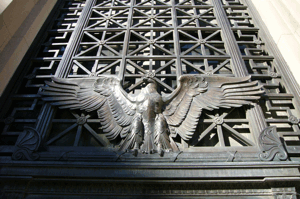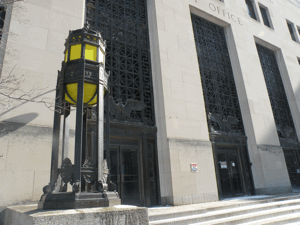From Court House to Home
Air Date: Week of May 7, 2010

The Alexander Company specializes in giving new life to old buildings. (Courtesy of the Alexander Company)
In Kansas City, an abandoned historic courthouse is getting a second lease on life. Host Jeff young speaks with Joe Alexander, president of the Alexander Development Company, about the benefits of adaptive re-use.
Transcript
YOUNG: Now when it comes to recycling we tend to think of glass and plastic and newspaper. But it can happen on a much larger scale. Entire buildings can be recycled. It’s a process called adaptive re-use, and Joe Alexander, president of the Alexander Company, specializes in partnerships with federal and state agencies to give old buildings new life. He is turning a 1939 courthouse in Kansas City into livable, low-income housing. He says it’s a special—as well as historic—building.
ALEXANDER: The courthouse like so many New Deal projects is a significant, public, government structure. It is a powerful-looking building; it’s a neo-classical design. So when you walk in the front door of the courthouse, you walk into a fantastic public space. The doors are bronze and include emblems that reflect the United States and justice. The court rooms themselves are two story spaces with huge, raised judge’s platforms. And Harry Truman kept his local senate office in this building. This was also the site of an important court decision involving desegregation of a local swimming pool called the Scope Park Swimming Pool decision that was argued in 1952 by Thurgood Marshall, of course he would later go one to represent the nation on the Supreme Court.
YOUNG: So with this reuse, someone’s going to end up in the room where “give ‘em heck” Harry, former president, used to do work? That’s go to be a pretty strong selling point for somebody, huh?
ALEXANDER: It is absolutely. It’s not only a strong selling point to attract people to live downtown, which is part of what makes urban development and adaptive reuse rewarding, but it is genuinely unique. It’s far different, and I think superior product from cookie cutter apartment and mixed-use building that you might find next to a highway or on the periphery.

The salvaged symbols of justice may now become home decorations. (Courtesy of the Alexander Company)
YOUNG: However, old building often have a lot of problems—they might have asbestos, or they’re not terrible efficient. They didn’t used to insulate buildings the way we might like to these days, for example. How do you overcome those kind of obstacles?
ALEXANDER: So dealing with simple things, really, like asbestos and lead paint abatement are things we do all the time. There’s established protocols and beyond that it is a challenge to bring new electrical and heating and cooling systems into a building like this. In the case of the courthouse, we’re lucky that these New Deal era buildings were built like tanks.
YOUNG: So we hear a lot about green building and big push to be greener than the Joneses when you’re building and incorporate what’s called LEED standards—Leadership in Energy and Environmental Design. How does that apply to reuse of old, historic buildings?
ALEXANDER: Well, I think it’s important to start with the background on LEED. It really used to help suburban developers atone for their sins and the sprawl they were creating so they could point to at least an attempt to be environmentally responsible. But the courthouse—if you were say, to tear it down, and in order to build a shiny, new, maybe LEED-certified building you would be demolishing 50 million pounds of existing material. You might be able to recycle a lot of those materials, but that in itself requires processing and time.

The Kansas City courthouse retrofit will save this historic site from becoming 50 million pounds of rubble. (Courtesy of the Alexander Company)
YOUNG: Yeah, I guess it is important to keep in mind that no matter how green we build something that’s new; building anything new has its footprint.
ALEXANDER: Yeah, I absolutely agree. The other really important aspect of a historic building is that they’re important to their community. In the case of the Kansas City courthouse, this building is when it’s completed or refurbished will provide 176 affordable, workforce housing units.
So not only are you attracting new employees downtown to revitalize your urban core, but you’re allowing for diversity both of income and ethnicity. And that is the social justice component of sustainability that’s at least as important as what type of carpet you might use.
YOUNG: Hmm, yeah, so projects like these have an obvious benefit for the city, but to pay for them, how are projects like these going in these strained economic times?
ALEXANDER: Well, there’s not very many of them going. The federal courthouse—the only way that this project was able to go forward like a lot of urban development projects was through a public/private partnership. In this case there was a major focus as part of the stimulus bill on shovel-ready projects. There are few projects that are as shovel-ready as the reuse of an existing building.
YOUNG: So, clearly a lot of advantages to reusing these historic buildings. However, I can think of one possible pitfall here, and that’s ghosts. Any complaints along those lines?
ALEXANDER: [Laughs] We just completely the adapted reuse of a former girl’s school that was later an annex to the Walter Reed Army Medical Hospital in Silver Spring, just outside of Washington, D.C., and we actually did receive a complaint from a resident that there may have been a ghost wandering in what was used as a ballroom by recuperating army soldiers after the Vietnam War.

The Alexander Company specializes in giving new life to old buildings. (Courtesy of the Alexander Company)
YOUNG: I guess this is part of the price of living in a historic building—you have to put up with maybe an old resident still sticking around.
ALEXANDER: We’re working on it, we’re learning about how to deal with ghosts all the time. That’s part of the benefit to it—it makes life a little more interesting.
YOUNG: [Laughs] Joe Alexander is president of the Alexander Company telling us about reuse of historic buildings. Thanks very much.
ALEXANDER: Thank you, I enjoyed it.
Links
Check out other Historic Adaptive Reuse Projects from the Alexander Company
Living on Earth wants to hear from you!
Living on Earth
62 Calef Highway, Suite 212
Lee, NH 03861
Telephone: 617-287-4121
E-mail: comments@loe.org
Newsletter [Click here]
Donate to Living on Earth!
Living on Earth is an independent media program and relies entirely on contributions from listeners and institutions supporting public service. Please donate now to preserve an independent environmental voice.
NewsletterLiving on Earth offers a weekly delivery of the show's rundown to your mailbox. Sign up for our newsletter today!
 Sailors For The Sea: Be the change you want to sea.
Sailors For The Sea: Be the change you want to sea.
 The Grantham Foundation for the Protection of the Environment: Committed to protecting and improving the health of the global environment.
The Grantham Foundation for the Protection of the Environment: Committed to protecting and improving the health of the global environment.
 Contribute to Living on Earth and receive, as our gift to you, an archival print of one of Mark Seth Lender's extraordinary wildlife photographs. Follow the link to see Mark's current collection of photographs.
Contribute to Living on Earth and receive, as our gift to you, an archival print of one of Mark Seth Lender's extraordinary wildlife photographs. Follow the link to see Mark's current collection of photographs.
 Buy a signed copy of Mark Seth Lender's book Smeagull the Seagull & support Living on Earth
Buy a signed copy of Mark Seth Lender's book Smeagull the Seagull & support Living on Earth

